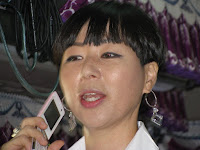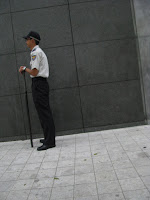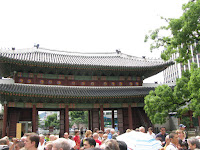In a hotel there is such a thing that – as Estonian journalist Vahur Kersna claimed five years ago in an overview of fishermen’s World Championship in South Korea –that the floors with numbers 4 and 13 are missing.
 13 is just the number of bad luck and 4 was said to be too similar to the word ‘death’, if I remember correctly. Similarly, all the floors missed rooms number 4 and 13. Our 13th floor thus had 15 as the number of the floor and of the room numbers we had 1514 just next to the room 1512 and our room was followed by the room number 1515.
13 is just the number of bad luck and 4 was said to be too similar to the word ‘death’, if I remember correctly. Similarly, all the floors missed rooms number 4 and 13. Our 13th floor thus had 15 as the number of the floor and of the room numbers we had 1514 just next to the room 1512 and our room was followed by the room number 1515.In Seoul we were first shown
 the residence of the president – the Blue House and already a kilometre before its location the guide forbade us making photos through the bus window.
the residence of the president – the Blue House and already a kilometre before its location the guide forbade us making photos through the bus window.  Walking alone on the last day, I was not allowed to film, but making photos was OK. The first guards on the street leading to the residence were policemen with shields
Walking alone on the last day, I was not allowed to film, but making photos was OK. The first guards on the street leading to the residence were policemen with shields  and over 1 metre truncheons.
and over 1 metre truncheons. Buses were their nests from where apparently exchange officers came.
Buses were their nests from where apparently exchange officers came.  The road was picked with white-collar people, who talked by radio sender from time to time.
The road was picked with white-collar people, who talked by radio sender from time to time.  Then we went to see one of the many wooden castles that remind of the feudal past: Changdeokgung (Changdeok Palace), ,
Then we went to see one of the many wooden castles that remind of the feudal past: Changdeokgung (Changdeok Palace), ,  that seemed to be not older than 200 years. But some buildings were indeed older, according to Wikipedia. At the same time it gave an impression on how things had looked like at the time. Despite the novel appearance, the castle has been listed in the UNESCO world heritage list thanks to some 15th century buildings. But the royal castle was surrounded by modern environment that mostly consisted of buildings with more than 10 floors.
that seemed to be not older than 200 years. But some buildings were indeed older, according to Wikipedia. At the same time it gave an impression on how things had looked like at the time. Despite the novel appearance, the castle has been listed in the UNESCO world heritage list thanks to some 15th century buildings. But the royal castle was surrounded by modern environment that mostly consisted of buildings with more than 10 floors.  The Norwegians recognised in the UNESCO world heritage symbol their Norwegian fox hunting badge,
The Norwegians recognised in the UNESCO world heritage symbol their Norwegian fox hunting badge,  that has been created around 1990, and in connection with this the question arose, which of them was plagiarism: the UNESCO emblem or the Norwegians’ badge.
that has been created around 1990, and in connection with this the question arose, which of them was plagiarism: the UNESCO emblem or the Norwegians’ badge.  Drawing on the example of that castle the yammer of our Estonian architects on the ‘Viru Son’ (additional building of the Hotel Viru on design) with the argument that Tallinn (capital of Estonia) might fall out of the UNESCO world heritage list if Viru Son will be build, is plain and simple bluff. If Viru Son would cause such disastrous consequences then the castle concerned would not have reached the world heritage list.
Drawing on the example of that castle the yammer of our Estonian architects on the ‘Viru Son’ (additional building of the Hotel Viru on design) with the argument that Tallinn (capital of Estonia) might fall out of the UNESCO world heritage list if Viru Son will be build, is plain and simple bluff. If Viru Son would cause such disastrous consequences then the castle concerned would not have reached the world heritage list.  The lunch took place in a business downtown restaurant specialising at catering for the American military personnel, there I got my first experience of eating with metal rice branches in Korea. Meat was laid on a gas grill at the centre of the table and was grilled under our eyes.
The lunch took place in a business downtown restaurant specialising at catering for the American military personnel, there I got my first experience of eating with metal rice branches in Korea. Meat was laid on a gas grill at the centre of the table and was grilled under our eyes.  route further led to the television tower where the men’s toilet is located, of which the whole city is proud.
route further led to the television tower where the men’s toilet is located, of which the whole city is proud.  The ‘easier thing’ can be done directly watching the city, without turning the view away from the city houses and the surrounding mountains.
The ‘easier thing’ can be done directly watching the city, without turning the view away from the city houses and the surrounding mountains.  The last attraction for us was visiting the local market street where trading with all kinds of stuff that suited to airing the pockets of the tourists took place.
The last attraction for us was visiting the local market street where trading with all kinds of stuff that suited to airing the pockets of the tourists took place. Then we hurtled back to hotel, where I found Kalle and Andres who had just finished with that I had done on the first day: had a rest of the travel. Then I really understood why the only matter of the first day on a trip from Estonia to Korea is going to hotel. Evidently the time difference and weariness of the trip can’t be survived otherwise.
So we accomplished the procedures of registration and put our equipment in order since training was scheduled for the next day.

No comments:
Post a Comment